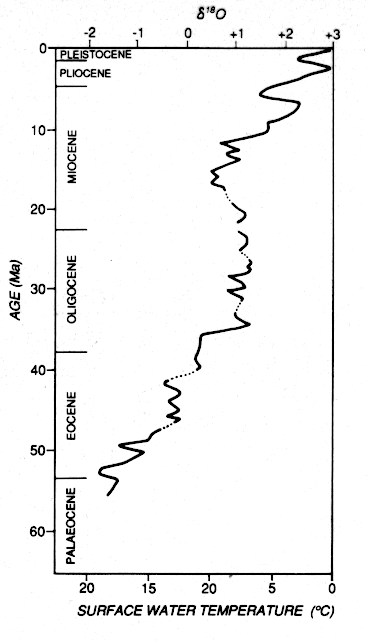
1. The decrease in global temperature
It appears that one major contributor to the trend is the occurrence of major mountain building processes. So we first considered evidence of the general cooling trend, then the mountain building process, the atmospheric changes due to mountain formations, and finally, some localized effects of mountain ranges on weather, in particular, the effects of the Himalayan Mountains on the Indian Monsoon.
http://www.gcrio.org/CONSEQUENCES/winter96/article1-fig6.html An overview of the mean global surface temperature over the past 100 million years.
The O18/O16 fractionation indicates ccooling temperatures in two
ways. As O16 easily evaporates and O18 does not, when precipitated
water is captured in ice sheets during cold periods, it will be the O16
molecule that is captured. The O18 remains in the ocean. Therefore,
the lowered amount of O16 has increased the ratio of oceanic O18/O16.
This is evidence of cooler temperatures indicated by the presence of ice.
Furthermore, the ratio is temperature dependent, meaning that it is directly
caused to increase with a decrease in temperature. Therefore, the
the shells of marine organisms that are recovered from deep-sea sediment
are indicative of both increased ice volumes and decreased ocean temperature.
The graph shows the increasing ratio of the Cenozoic era.

2. Mountain building processes
diagram of continental-continental collision
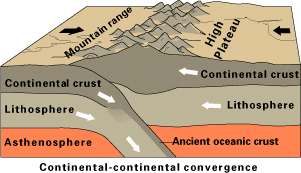
Indian and Eurasian plate collision
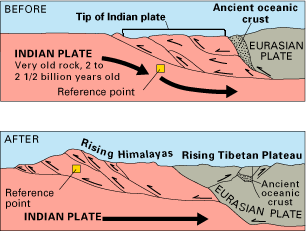
Overview of the rise of the Tibetan Plateau due to the collision of the Indian and Eurasian plates
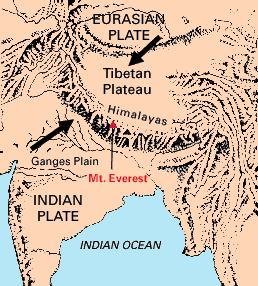
Time line of the Indian plate moving north and eventually colliding with the Eurasian plate.
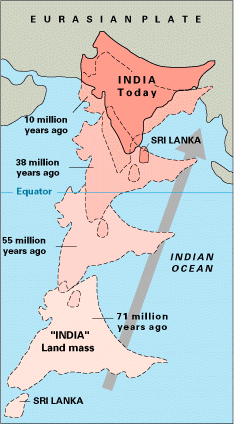
the break up of Pangea starting 225mya
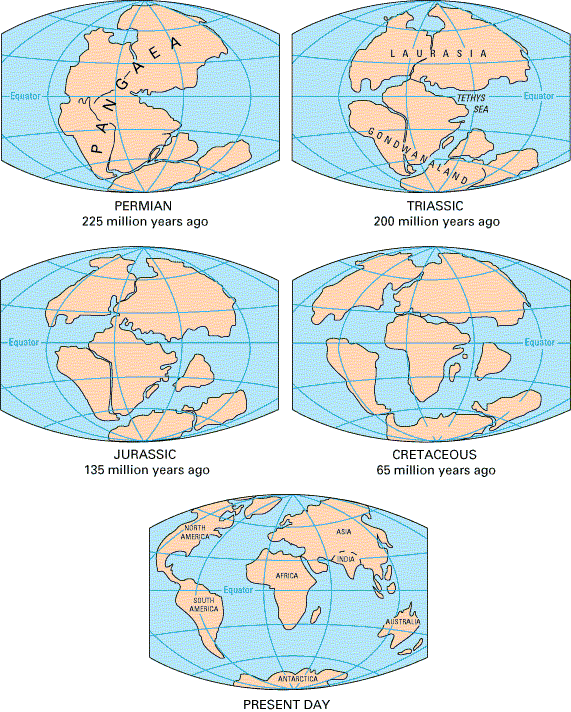
Diagram of the forces driving plate motion
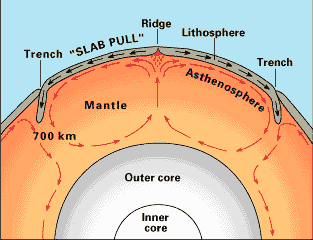
Diagram of different plate boundaries
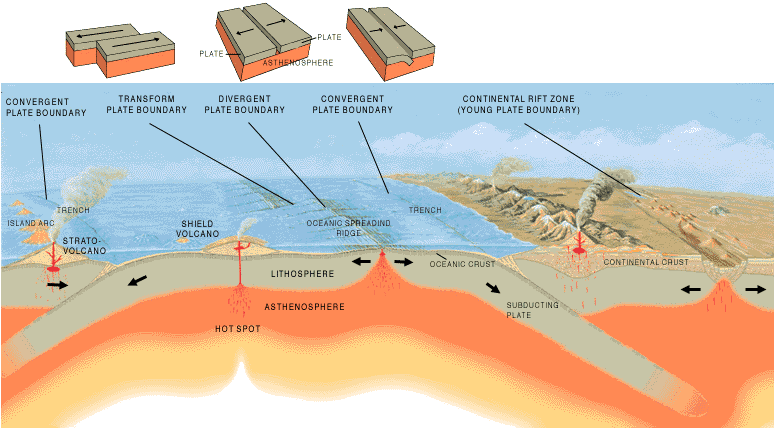
3) How mountain building influences the atmosphere
-What is chemical weathering?
Rock + Carbon dioxide-->Calcium Carbonate + Sand Quartz
-The opposit is metamorphosis.
-In weathering Calcium Carbonate goes into the ocean and is ficed in
shells.
-Metamorphosis-Quartz and Calcium Carbonate under pressure and heat
are
metamorphosed back into rock in the mantle, Carbon dioxide is released
in
volcanoes.
-Does decrease in Carbon dioxide mean decrease in volcanoes?
-Surface area of Tibetan plateau is very large. More area to weather
-Mechanical weathering helps.
-Summer Monsoon increases weathering.
3) INDIAN MONSOON
The word "Monsoon" refers to the reversal of wind direction in
a region between seasons. The major driving factor of
the Indian Monsoon is differential heating. This refers to the way
in which water takes longer to heat, but then stores heat longer, while
land heats quick, but releases heat quicker, also. Therefore, in
the summer months, land rapidly heats, while the oceans sees little change.
In the winter, however, land rapidly loses heat, while the ocean sees little
change. Therefore, there is a temperature gradient created moving from
land to water.
This is the case in the Indian Ocean, with the Indian subcontinent,
as well as the world's largest continuous landmass, to the north.
http://iri.ldeo.columbia.edu/~krishna/monsoon/1fig1.gif
This is a map of the Indian Ocean, as well as the surrounding landmasses--India
directly to the north.
As air heats over the land, it becomes less dense and rises.
The adjacent moist, dense air over the ocean then moves in to fill the
space.
Thus, a current moving inland is created. The large landmass
to the north of the Indian Ocean is enough to create this effect.
In addition to this, however, there is the large surface area, as well
as highly elevated surface of the Himalayas and the Tibetan Plateau.
The presence of the extreme mountains and the large, elevated landmass
of the plateau which are heated serves to draw the air inland and then
up. As the air is drawn in such a pattern, it sweeps up the mountains,
cools, and drops its moisture, creating the monsoon precipitation in its
stead.
http://iri.ldeo.columbia.edu/~krishna/monsoon/1fig2.html
This 3D graphic shows the pattern of the air current as it moves north
over the
equator, towards the west, hits the Somalian Coast, then travels across
the Arabian Sea, and over the Indian subcontinent.
SUMMARY
This has been a look at the effects of the
mountain building processes of the Cenozoic era, which appear to have had
a strong influence on the climate of the time period--cooling by way of
the chemical weathering that took CO2 out of the atmosphere. Furthermore,
we have looked at the localized effects of the young Himalayan Mountains.
These climatic effects serve to fuel the agricultural base of the region.